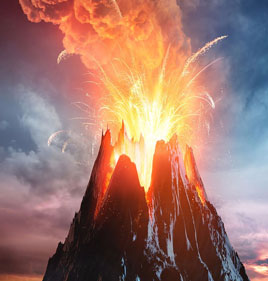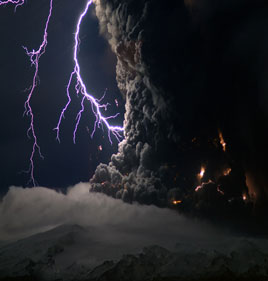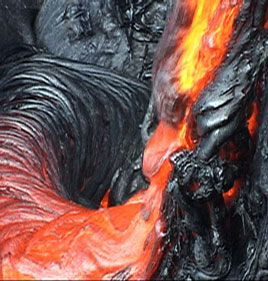




How does a
volcano form?
Plate
tectonics is the very beginning point in how a volcano
begins it's journey through the world of physics.
Effectively a plate is a slab of rock floating on this
semi-fluid semi-solid part of the earth called the
Lithosphere.
Since plates are
constantly moving, they are constantly rubbing against each
other which causes friction. The friction heats up the
plates, and causes them to melt down into a substance called
magma. Magma is a liquid form of the rocks that is beneath
the surface of the earth, when this liquid magma
reaches the surface we call it lava.
As the
plates heat and cause magma to form through the friction of
the plates grinding against each other, this builds up
pressure which forces the magma into cracks throughout the
crust of the Earth. This process results in magma being
pushed to the surface of the Earth, which flows out of the
ground and forms what we call a volcano.
Originally, scientist
believed that the movement of the plates was caused by
mantle convection. However the Geological Society of the UK
mentions that slab pull is thought to be the culprit.
![]()
![]() As the
theory of plate tectonics developed, mantle convection was
long thought to be responsible for the movement of tectonic
plates across the Earth’s surface. This theory is now
largely out of favour[sic], with modern imaging techniques
unable to identify convection cells in the mantle
sufficiently large to drive plate movement. Instead, it is
thought to be caused by 'slab pull'.
As the
theory of plate tectonics developed, mantle convection was
long thought to be responsible for the movement of tectonic
plates across the Earth’s surface. This theory is now
largely out of favour[sic], with modern imaging techniques
unable to identify convection cells in the mantle
sufficiently large to drive plate movement. Instead, it is
thought to be caused by 'slab pull'.![]()
~The Geological Society of the United Kingdom
![]()
Slab pulling is caused by the tectonics plate
being subducted into the earth. This implies that the plate
motion is caused by the weightof the plates sinking into the
oceanic trenches.
 How does physics tie into
this?
How does physics tie into
this?
There are multitude of different ways
physics pertains to the tectonic activity of the earth.
However, we will be focusing on how plate tectonics obeys
Newtons first law and Newton's second law,
Newton's first law states
that an object at rest will stay at rest and an object in
motion will stay in motion unless there is a force acting
against it. This applies to our plates since they are
moving by the slab pulling process. The slab pulling
process is described with the following equation:
This leads us up to the next process, Newton's
second law. This states that the sum of all the forces
on an object will equal that objects mass*acceleration.
It's given by the following formula:
![]()
What makes this really interesting
is that the friction that was mentioned earlier in
this page also plays into the forces that are
responsible for the acceleration of the plates, and
that friction also plays a role in forming the magma.
Interestingly, Professor Martin Van Kranendonk and his
research team has noticed that plates have been
undergoing a process of slowing down. This implies
that there is some force causing a negative
acceleration on the plates which was reported by
NewScientist.
![]()
![]() A study last
year by Martin
Van Kranendonk at the University of New South Wales in
Sydney, Australia, and colleagues measured elements
concentrated by tectonic action in 3200 rocks from around
the world, and concluded that plate
motion has been slowing for 1.2 billion years.
A study last
year by Martin
Van Kranendonk at the University of New South Wales in
Sydney, Australia, and colleagues measured elements
concentrated by tectonic action in 3200 rocks from around
the world, and concluded that plate
motion has been slowing for 1.2 billion years.![]()
~NewScientist
![]()
Considering all the
evidence it's really easy to see why and how the physics of
the universe play into how volcanoes are formed. Without
Newtons laws, the Earth as we know it would not exist. It's
also worth mentioning that this is just a brief overview of
plate tectonics and the process is a bit more complicated
than what was covered in this article. Please feel free to
check out the bibliography at the top of the page for some
sources that delve a lot further into the topic.
